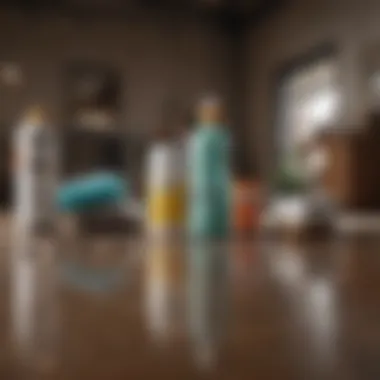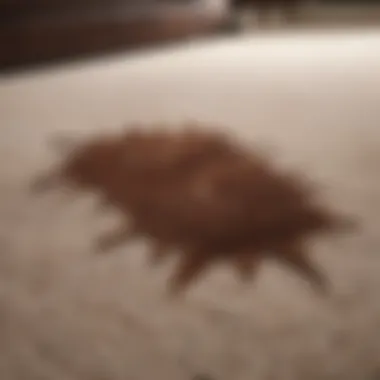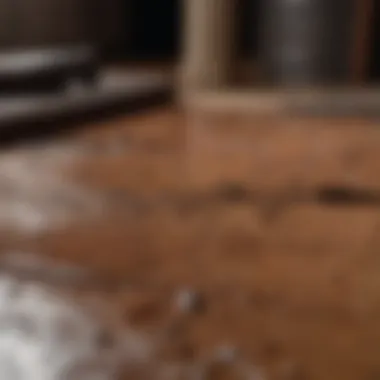Effective Strategies for Removing Chocolate Stains


Intro
Many homeowners and design enthusiasts often overlook the impact of stains on the aesthetics of their living spaces. Chocolate, being a beloved treat, can easily mar the appeal of fabrics and surfaces in homes. This guide aims to educate readers about the best methods for tackling these stains successfully. It includes specific cleaning procedures for different materials, preventive measures to consider before an event, and professional options for stubborn instances.
By the end of this article, readers will gain a better grasp of how to handle chocolate stains efficiently. They will have access to techniques that not only preserve their investment in home furnishings but also enhance their overall experience as hosts. Let's delve into the practical strategies that ensure chocolate stains remain a minor inconvenience rather than a major disaster.
Foreword to Chocolate Stains
Chocolate stains are a frequent concern for many households. The enjoyment of chocolate, whether it's from a dessert or a simple snack, can quickly turn into frustration when it leaves a mark on clothing, upholstery, or carpets. Understanding how to effectively tackle these stains is critical because chocolate contains oils and pigments that adhere firmly to various surfaces.
Several key elements influence the effectiveness of stain removal strategies. First, it’s vital to recognize the nature of the chocolate stain—its composition and the type of fabric or surface affected. Second, promptness plays a crucial role in stain management. The sooner a stain is treated, the higher the chances of completely removing it. Furthermore, various cleaning methods exist, from household remedies to commercial products, tailored to specific materials.
By learning about the types of chocolate stains and how to address them, homeowners and caretakers can save time and resources. Efficient stain removal not only maintains the aesthetic appeal of fabrics but also prevents permanent damage, ultimately prolonging their lifespan.
"Understanding the science behind stains can empower individuals to act quickly and effectively."
This article delves into the essential aspects of chocolate stains. We explore the composition of chocolate, its specific characteristics as a stain, immediate actions for treatment, remedies from the home, and even professional solutions. Understanding these facets will ensure that readers are well-equipped to handle chocolate stains confidently and effectively.
Initial Steps for Stain Treatment
When addressing chocolate stains, understanding the initial steps in treatment is crucial for effective removal. These steps lay the foundation for successfully tackling the stain, regardless of the fabric type or surface. It is essential to act swiftly and correctly. Failure to do so might set the stain, making future removals more difficult.
Prompt actions can minimize the damage and increase the chances of complete removal. Here, we will go through two main aspects: assessing the surface material and immediate actions to take.
Assessing the Surface Material
The first thing you need to do is identify the surface material that has the chocolate stain. This step is critical because different fabrics and materials require different cleaning methods. For instance, cotton can often withstand more aggressive treatment compared to silk. Start by examining the stain closely.
- Type of Fabric: Is it a sturdy fabric like denim, or is it more delicate like silk? This distinction affects the cleaning approach.
- Colorfastness: Before using any cleaner or method, it can help to do a patch test on a hidden area to check that the colors do not bleed or fade. This will save you from inadvertently making the situation worse.
- Material Composition: Recognizing if the surface is a natural fiber versus synthetic can guide you towards the right cleaner. Some cleaners might damage particular materials.
Understand the nature of the surface you are dealing with. This information is vital for planning your next steps.
Immediate Actions to Take
Once the surface is identified, it’s time to take immediate actions to contain the stain. Initial responses can significantly affect the outcome of the stain removal process.
- Act Quickly: The sooner you address the stain, the better the results. If you can, treat the stain within minutes.
- Remove Excess Chocolate: Gently scrape off any solid chocolate without rubbing it deeper into the fabric. Use a dull knife or a spoon.
- Blot, Don’t Rub: Use a clean, dry cloth or paper towel to blot the stained area. This technique lifts the stain without spreading it further.
- Cold Water Rinse: Rinse the stain with cold water from the back of the fabric, pushing the chocolate out rather than through.
Remember: Avoid hot water initially. Hot water can set the stain, making it more challenging to remove.
By following these immediate actions, you create the best environment for later cleaning treatments, be it home remedies or commercial products. Keeping calm and methodical during this stage can save considerable time and effort in the long run.
Home Remedies for Chocolate Stains
Removing chocolate stains can seem like a daunting task. However, home remedies provide practical solutions using everyday items readily available in most households. These methods are often cost-effective and safe for various fabrics, appealing to both novice and experienced cleaners. By employing these techniques, you can address chocolate stains promptly and minimize the risk of permanent marks. Moreover, familiarizing yourself with these remedies gives you control over cleaning processes, enhancing overall satisfaction when dealing with fabric care.
Using Cold Water and Soap


Cold water is a crucial first step in addressing chocolate stains. It helps prevent the stain from setting deeper into the fabric. Begin by gently scraping off any excess chocolate without pushing it further into the material. Use a dull knife or spoon for this purpose. Once you have removed the bulk of it, turn the stained area under cold running water, allowing the water to flow through the fabric.
Then, apply mild soap directly to the stained area. Use a gentle, non-abrasive soap such as dish soap or laundry detergent. Allow it to sit for a few minutes and then repeat the rinsing with cold water. This method is particularly effective for cotton and polyester products.
Applying Vinegar and Baking Soda
A combination of vinegar and baking soda acts as a powerful stain remover. Vinegar is known for its ability to break down the chocolate's fat content, while baking soda acts as an abrasive and deodorizer. To utilize this method, mix equal parts of white vinegar and water in a spray bottle.
Spray the solution onto the stained area. Let it sit for approximately 10-15 minutes. Afterward, sprinkle baking soda directly onto the stain. The reaction between vinegar and baking soda will bubble and lift the stain. Gently blot the area with a cloth or sponge, ensuring not to scrub harshly, as this could damage the fabric. Rinse well with cold water afterward to remove all residues.
Utilizing Cornstarch Absorbent Properties
Cornstarch is a highly absorbent substance, making it suitable for tackling chocolate stains efficiently. First, apply a generous amount of cornstarch onto the stain. Allow it to sit for at least 30 minutes. This gives it enough time to absorb the oils and chocolate residues. Afterward, simply brush off the cornstarch with a dry cloth or shake it out gently. This method is especially effective on delicate fabrics, such as silk and some synthetic blends, as it does not involve the use of harsh chemicals.
Commercial Cleaning Solutions
Commercial cleaning solutions play a vital role in effectively removing chocolate stains from various surfaces. They offer a tailored approach that can complement home remedies and standard cleaning practices. The importance of commercial stain removers lies in their specialized formulas designed to target specific types of stains, including chocolate. These products can penetrate deeply into fabric fibers, breaking down the cocoa and fat components that contribute to stubborn stains.
1. Benefits of Commercial Stain Removers
Using commercial cleaning solutions can provide several advantages:
- Effectiveness: Many products are scientifically formulated to enhance cleaning efficiency, often outperforming homemade solutions.
- Specificity: Different products are available for diverse materials, ensuring a match between the cleaner and the fabric type.
- Ease of Use: Most commercial products come with clear instructions, simplifying the stain removal process for users.
- Time-saving: They can often reduce the time spent on cleaning tasks compared to alternative methods.
However, it is essential to consider the ingredients used in these products, as some may contain harsh chemicals that can be detrimental to delicate fabrics or the environment. Always read labels to ensure compatibility with your specific cleaning needs.
Understanding Stain Removers
Choosing the right stain remover requires a basic understanding of different product types. Stain removers typically fall into two categories: enzymatic and non-enzymatic.
- Enzymatic Stain Removers
These products contain enzymes that break down organic materials. They are particularly effective on protein-based stains but can also work well on chocolate. - Non-Enzymatic Stain Removers
These are chemical-based products that attack stains through various reactions. They may be effective on a wider range of stains but could be harsher on fabrics.
Understanding these differences can guide users in selecting a product that best suits their needs. It is also advisable to test any product on a small, inconspicuous area first.
Selecting the Right Product
When deciding on a commercial cleaning solution, several criteria should guide your selection:
- Fabric Type: Ensure the cleaner is safe for the specific material you are working with, such as cotton, silk, or upholstery.
- Stain Type: Look for products specifically formulated for chocolate stains or those that indicate effectiveness against greasy or oily residues.
- Eco-friendliness: Consider opting for biodegradable products that have less impact on the environment, especially for frequent use.
- User Reviews: Searching for consumer feedback can provide insight into a product's efficacy and reliability before making a purchase.
Follow-Up with Laundry Techniques
After applying a commercial cleaning solution, following up with proper laundry techniques is crucial:
- Cold Water Rinse: Rinse the treated area in cold water to remove any residue from the cleaning solution and the stain.
- Detergent Application: Use a mild laundry detergent, ideally one free of bleach, to wash the fabric gently.
- Air Dry: Instead of using a dryer, allow the fabric to air dry to prevent any remaining stain from setting further.
By incorporating commercial cleaning solutions and proper follow-up methods, homeowners can effectively manage chocolate stains. This comprehensive approach empowers users with every tool necessary to protect their fabrics and maintain a clean home.
Special Considerations for Various Fabrics
When it comes to removing chocolate stains, the type of fabric plays a crucial role. Different materials react differently to stains and cleaning agents. Understanding these variances can lead to more effective stain removal strategies and help prevent damage to your valued items. This section will discuss how to handle chocolate stains on cotton, silk, upholstery, and carpets.


Dealing with Cotton and Denim
Cotton and denim are robust fabrics, often found in casual wear and home textiles. They can usually withstand a good wash without sustaining significant damage. To treat chocolate stains on these materials, first, gently scrape off any excess chocolate with a dull knife. Avoid using your fingers, as this can push the stain further into the fibers.
Next, run cold water through the fabric from the back, allowing the chocolate to be pushed out rather than deeper in. After rinsing, apply a mild detergent directly to the stain. Let it sit for a few minutes before rinsing it again. Most of the time, cotton and denim will respond well to this simple cleaning technique; however, repeat the process if necessary until the stain is gone.
Handling Silk and Delicate Fabrics
Silk and other delicate fabrics demand a more cautious approach. These materials often require special attention due to their fine fibers. If a chocolate stain occurs, begin by blotting the stain gently with a clean cloth. This helps absorb the excess liquid without spreading the stain.
After blotting, avoid rubbing the fabric as this can damage the texture. Instead, use a mixture of cold water with a small amount of gentle silk detergent. Apply this solution to the stain and blot it again using a clean cloth. Rinse by dabbing with pure cold water and ensure to air dry the fabric afterward. If the stain persists, it is prudent to consult a professional cleaner experienced with silk fabrics.
Stain Removal on Upholstery
Upholstered furniture presents its own set of challenges when dealing with chocolate stains. The approach for upholstery depends heavily on the fabric type. However, the general process starts with blotting the excess chocolate away carefully without pushing it in.
For most fabrics, a mild detergent diluted in water can be applied with a soft cloth. It is important to test any cleaning solution on a small hidden area first to ensure it does not discolor the fabric. After applying, scrub gently, then wipe off any foam with a clean, damp cloth. If the chocolate is particularly ingrained, it may be necessary to repeat this process or even hire a professional service.
Cleaning Chocolate Stains on Carpets
Cleaning chocolate stains from carpets can be quite daunting due to the depth of fibers. Quick action is needed. Start by scraping off any solid pieces carefully, as with other fabrics. Then, blot the stain with a clean cloth to absorb any excess moisture.
For carpet cleaning, creating a solution of half white vinegar and half water can be effective. Saturate a soft cloth with this mixture and blot the stain continually. This method can help lift the chocolate without damaging the fibers. Make sure to rinse the area with a bit of water afterward and blot up the excess moisture. If the stain proves challenging, professional cleaning may be the best route to take for preserving your carpet's integrity.
"Different fabrics require different cleaning methods to avoid damage while effectively removing stains."
Understanding the specific needs of each fabric can save time and help maintain the quality of your items. Adjusting your methods based on fabric type ensures successful chocolate stain removal.
Persistent Stains and Professional Help
Addressing chocolate stains effectively requires a well-rounded approach. At times, despite all efforts, stains can persist. This section explores the significance of recognizing persistent stains, as well as the benefits of seeking professional assistance. Understanding these elements is crucial for homeowners and anyone who manages fabrics that are susceptible to stains.
Identifying Stubborn Stains
Identifying stubborn stains is the first step towards effective treatment. Chocolate can create intricate issues, especially when it contains oils, sugars, or dairy. These components often penetrate fabric fibers, making extraction challenging. Observe the following aspects:
- Type of Fabric: Some materials are more absorbent and may hold stains longer.
- Duration: Stains that have set for a longer time prove more difficult to remove.
- Texture Changes: Feel for any changes in the fabric's texture, as embedded oils can alter its surface.
Using specific techniques can help, such as:
- Visual Inspection: Look closely at the stain. If it looks dry and dark, it may be stubborn.
- Rubbing Test: Gently rub the stain with a cloth. If color transfers to the cloth, it may indicate the stain is indeed embedded.
Recognizing these signs can guide the next steps toward treatment or professional help.
When to Consult a Professional
Knowing when to call in professionals can save time and prevent further damage. There are several factors that signify the need for expert assistance:
- Multiple Attempts: If home cleaning efforts fail after multiple tries, seek help.
- High-Value Fabrics: Items like silk, wool, or upholstery may require specialized care. Their delicate nature means improper treatment could lead to further damage.
- Persistent Odor: Chocolate stains can leave behind unpleasant smells. Professionals use advanced techniques for deep cleaning and deodorization.


In summary, if stain removal efforts strain resources or time, consider hiring experts. They possess tools and knowledge beyond everyday remedies. Using professional cleanrs not only reduces the risk of further damage but assures the best potential outcome in stain removal.
"When in doubt about a stain, it's better to consult an expert before making the situation worse."
Implementing these strategies into routine cleaning practices can set the foundation for successful stain management, allowing you to enjoy your material possessions without the worry of chocolate mishaps in the future.
Preventative Measures for Future Incidents
Preventing chocolate stains is often easier than removing them once they occur. Understanding the importance of preventative measures can save time, effort, and frustration in the long run. By taking proactive steps, homeowners and party hosts can maintain the integrity of their fabrics and surfaces. Let’s dive into some effective strategies to reduce the likelihood of chocolate mishaps.
Opting for Protective Fabrics
One of the most straightforward ways to prevent chocolate stains is by choosing the right fabrics. Protective materials, like synthetic fibers, often resist staining better than natural ones. These fabrics can be treated with various finishes that increase their resistance to spills and stains. Here are a few suggestions when selecting fabrics:
- Microfiber: This material is easy to clean and often repels stains well.
- Polyester Blends: These can provide durability and resistance to stains.
- Waterproof or Water-Resistant Fabrics: Ideal for furniture and upholstery, these fabrics can help keep spills from soaking in.
Consider using table covers made from durable materials during gatherings. They can provide an extra layer of protection against accidental spills. This option is especially useful for party hosts or families with young children. Investing in quality, protective fabrics can be a key strategy in minimizing the risk of chocolate stains on valuable textiles.
Utilizing Stain Repellent Treatments
Another effective preventative measure is applying stain repellent treatments to existing fabrics. These treatments create a barrier that can help prevent chocolate and other stains from adhering to the material. Here are some popular options:
- Fabric Protectors: Products like Scotchgard can be applied to various textiles and upholstery to enhance their resistance to stains. Just ensure to follow the manufacturer's instructions carefully.
- DIY Solutions: Homeowners can create their own stain-repellent spray using a mix of water and a small amount of white vinegar or rubbing alcohol. This can provide a temporary protective barrier, but it may require more frequent application.
- Regular Professional Cleaning: Engaging professional cleaning services that specialize in fabric protection can ensure treatment is applied correctly. This not only helps in preventing stains but also prolongs the life of the material.
Taking these precautions can greatly reduce the occurrence of chocolate stains. Implementing protective fabrics and treatments can be beneficial for everyone but particularly essential for those hosting gatherings or with children, where chocolate-covered treats may be a common occurrence.
"An ounce of prevention is worth a pound of cure."
Culmination and Summary
Chocolate stains, ubiquitous yet formidable, require a comprehensive approach for effective removal. This article has detailed various strategies that cater to different surface materials and stain scenarios. Understanding the characteristics of chocolate is vital. Its composition can affect how quickly and effectively a stain is treated. Inadequate knowledge may lead to ineffective cleaning attempts, further embedding the stain.
Key elements in this guide include immediate actions to take post-incident, reliable home remedies, and the importance of selecting appropriate commercial cleaning products. Each fabric type presents unique challenges; thus, specialized techniques contribute to better outcomes. Homeowners, interior design enthusiasts, and party hosts can benefit immensely from understanding the intricacies involved in stain treatment.
Additionally, preventative measures are crucial. They not only reduce the likelihood of stains but can also provide peace of mind in settings where chocolate treats are present. An informed approach leads to far better results than merely applying random solutions.
"Prevention is better than cure." In the context of chocolate stains, this adage holds significant weight.
Consistently revisiting and practicing these methods will help adapt to various situations with confidence.
Revisiting Key Strategies
The main strategies for chocolate stain removal revolve around understanding the nature of the fabric and the type of chocolate involved. One should remember to assess the surface material before proceeding. Immediate actions, such as scraping away excess chocolate without spreading the stain, set the foundation for successful treatment.
Home remedies, like using cold water and soap or vinegar mixed with baking soda, provide effective solutions for many common fabrics. For those stubborn cases that resist DIY methods, identifying the right commercial cleaning solution that suits the specific fabric type becomes essential.
To encapsulate:
- Assess the fabric before treatment.
- Act quickly to manage fresh stains.
- Explore proven home remedies.
- Know when to switch to specialized products.
Final Thoughts on Stain Management
Managing chocolate stains can seem overwhelming, yet a systematic approach simplifies the task. Being proactive, such as using protective fabrics and stain repellent treatments, not only mitigates potential disasters but also enhances confidence while entertaining or hosting.
In light of all discussed strategies, persistence and adaptability are key. As new cleaning products and techniques emerge, homeowners should stay informed and adjust their methods accordingly.



